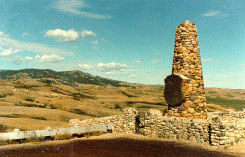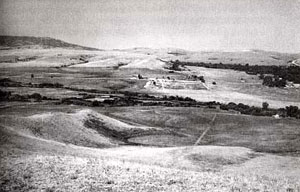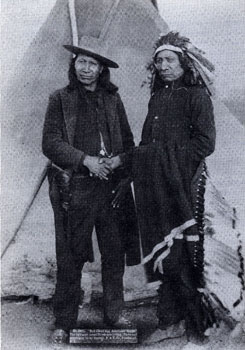|

Fort Phil Kearny
P.O. Box 520
Story, WY 82842
Phone: 307-684-7629
History
1866-1868
Named for a popular Union general killed in the Civil War, Fort Phil Kearny was established at the forks of Big and Little Piney Creeks by Col. Henry B. Carrington of the 18th U.S. Infantry in July, 1866.The Mission of this fort and two other posts along the Bozeman Trail, Forts Reno and C.F. Smith, was three-fold: to protect travelers on the Trail; to prevent intertribal warfare between Native Americans in the area; and to draw attention of Indian forces opposed to Euro-American westward expansion away from the trans-continental railroad construction corridor to the south.
All three Bozeman Trail forts were stockade fortifications, with Fort Phil Kearny being the largest. Enclosing seventeen acres, the fort wall was eight feet high, 1,496 feet in length, and tapered in width from 600 feet on the north to 240 feet on the south. More than four thousand logs were used to erect the stockade, while over 606,000 feet of lumber and 130,000 bricks were produced in 1867 alone for the extension building construction.
During its two year existence, Fort Phil Kearny was the focal point of a violent war between the U.S. Army and the Sioux, Cheyenne, and Arapaho Indians opposed to intrusions into the last great hunting grounds on the Northern Plains. Besides the Fetterman and Wagon Box battles, many smaller fights took place in the area.
By 1868, the Union Pacific Railroad had reached a point to the west where travelers could bypass the Bozeman Trail route by going to Montana through Idaho, thus making the Bozeman Trail forts expensive liabilities. In the Treaty of 1868, the United States agreed to close the forts and the trail.Fort Phil Kearny was abandoned by the Army in early August, 1868, and burned soon afterwards by the Cheyenne. In 1963, Fort Phil Kearny was designated a National Historic Landmark. Today, portion of the fort site and the Fetterman and Wagon Box battlefields are included within the Fort Phil Kearny State Historic Site boundaries.

Picture from the book, Encyclopedia of Indian Wars, by Gregory F. Michno.
Travel Directions and Park Overview
Fort Phil Kearny State Historic Site is located just twenty miles south of Sheridan on Interstate 90, Exit 44. At the Fort location the visitor will find an interpretive center with exhibits, videos, bookstore, and self-guided tours of the fort and outlying sites. The fort tour leads the visitor through the site to building locations, archaeological remains, and interpretive signs pinpointing the surrounding historic landmarks. A Civilian Conservation Corp. Cabin has been refurbished to depict the quarters of an Officer’s wife and a Non-Commissioned Officer’s Quarters. In addition to the historic interpretation, this site provides three picnic areas and a restroom for visitor use.
The two satellite sites of Fort Phil Kearny are the Fetterman Fight and the Wagon Box Fight battlefields. These two sites are located within a five-mile radius of the Fort Phil Kearny Visitor Center. Maps to the sites and interpretation are available at the Visitor Center. At both battlefields, the visitor will find an interpretive trail which leads through the battle providing both Indian and White perspectives of the conflict. The visitor can go to the actual locations of the skirmish lines and Indian charges and see the weapons and personnel involved. The Wagon Box Fight site provides the visitor with restroom facilities; also a picnic area where they may relax and enjoy the beautiful scenery.
All interpretive trails and facilities are either partially or fully accessible for the ADA. Guided tours of these three sites for social groups, schools, or special events may be scheduled through advance reservation. Accommodations and Camping
Fort Phil Kearny is designated "day use only." There is no camping allowed at this site. The nearest State Park campground is Connor Battlefield located at the town of Ranchester . Other public campgrounds included Lake DeSmet or one of several campgrounds in the Big Horn Mountains .
Larry McMurtry describes the December 21, 1866 Fetterman massacre through the eyes of characters in his novel Boone's Lick.
Just then we heard a bugle, though we could see no soldiers. There was a kind of ridge between us and the troops--it was called Lodgepole Ridge, though I didn't know that until much later.
As soon as they heard the bugle about half the Indians that had been circling us pulled off and went to the little group that had just loped into the valley.
The warrior with the sore-footed horse was all by himself, warming himself by his little fire.
Then the cavalry began to pour over the little ridge, with a bugler and a flag and Colonel Fetterman in the lead--I recognized him by his white gloves.
"The goddamn fool, don't he see that it's a trip!" Pa yelled.
I thought he'd be happy that relief was finally coming, but he wasn't happy. He began to jump up and down on the wagon, waving his arms and yelling for the soldiers to go back.
Of course, they were a mile or two away--they couldn't hear him. Even if they had, it's not likely Colonel Fetterman would pay much attention to a woodcutter.
The six or seven Indians who had just loped up the valley took fright when they saw the cavalry--they hit out across the valley for the nearest trees.
Only the lone Indian with the sore-footed horse didn't seem concerned. He scattered his little fire and hopped on his horse, watching the soldiers for a minute before he went trotting off.
"Decoys! Decoys! That's all they are," Pa said, jumping off the wagon. "Hasn't the damn fool been in the army long enough to learn about decoys?"
"Hey, what's the army doing?" G. T. asked. "They're supposed to rescue us."
That had been my opinion too--and even the opinion of the Indians who were harassing us--the minute they saw the cavalry most of them began to peel off towards the woods.
Maybe Colonel Fetterman had meant to rescue us, when he left the fort, but the sight of those decoy Indians swayed his judgment. The cavalrymen had been moving along at a slow gallop, but then the bugler blew the charge. I guess the colonel thought he could cut those few Indians off before they reached the woods.
In a minute the cavalry was in full charge, headed for the Indian with the sore-footed horse--only his horse made a quick recovery and wa soon outrunning the soldiers.
"The oldest trick, the wounded bird," Pa said.
The cavalry was deep in the valley now, but they weren't catching the Indians, who were on fine quick horses.
"Look, Sam," Pa said.
"Oh, Lord," Sam said.
"Oh, dern," G.T. said.
The woods on every side began to boil with movement--I wasn't sure what was happening, at first. There was so much snow kicked into the air that I thought it might mean some kind of avalanche, caused by a buffalo herd that had decided to pass through.
But it was all Indians, hundreds of Indians, maybe thousands, and the war cries they screamed as they plunged into battle nearly scared my scalp off, and G.T.'s too. In nightmares I still hear those war cries today.
In a minute the Indians had closed around the cavalrymen--the few cavalrymen who tried to retreat were quickly cut down. There were so many arrows in the air that they made a cloud. I even saw a crow fall--it had just been flying low over the valley and suddenly found itself stuck with arrows.
"We better go, while they're busy," Pa said, crawling up on the wagon seat.
"Oh, they don't want us," Sam said.
That seemed to be true--the Indians who had been circling us pulled away to join the general battle; guns were popping all over the valley, arrows and lances skewered men on the run, while others got hacked down with hatchets.
"No, they don't want us, but the frenzy's on them," Pa said. "They might not be able to stop killing. Some of the young warriors might want a few more easy scalps."
Most of the woodchoppers were like frozen men, staring at what was happening in the valley below. The cavalry had long since been scattered into many groups, pockets of five or six men, all fighting for their lives and losing--falling.
Even Sam seemed frozen by the spectacle.
"I would never have expected Indians to hold an ambush this well," he said.
"Well, they're learning," Pa said. "Come on, boys--whip up! Now's our chance, if we've got a chance."
G.T., Sam and his dad make good their escape. McMurtry gives his own account of the event in his book Crazy Horse.
Fetterman was an arrogant young man who had no regard for Indians; he had publicly said that with eight men he could march through the whole Sioux nation. On that cold December day he got his chance. He demanded that Carrington let him lead a troop of men in the defense of some woodcutters who were being harassed by a few Indians. Carrington consented, but with reluctance. He would have preferred to send a more reliable officer, but finally yielded to Fetterman's demands--though he made it clear that on no account was Fetterman to follow the Indians over Lodge Trail Ridge.
Captain Fetterman, having bullied his way into the assignment, rode out of the fort with eighty men, the very number he had said he could ride through the whole Sioux nation with. The Sioux and the Cheyennes, in large numbers, had been waiting with uncharacteristic patience, hoping a sizable group of soldiers would expose themselves. For once, the young warriors refrained from spoiling the ambush. Crazy Horse led a party of decoys whose job it was to tempt the soldiers to go where they had been told not to go: over Lodge Trail ridge, a move that would take them out of sight of the fort.
The soldiers, of course, were no strangers to the decoy tactics; they wee not easily tempted. The legend is that it was Crazy Horse who skillfully and successfully played the wounded bird, leading the soldiers farther and farther from safety. He dismounted several times, pretending that his horse was lame; at one point he even built a small fire. Captain Fetterman had not insisted on taking this command merely to protect a few woodcutters. Eventually, ignoring his strict orders, he took the bait, led his soldiers over Lodge Trail Ridge, and went down the other side. The Indians, in this instance perfectly disciplined, sprang the trap: in half an hour or less Captain Fetterman and his eighty men were dead. By some accounts Captain Fetterman save his last bullet for himself; American Horse, however, claimed that he clubbed him down and cut his throat. Red Cloud, who probably wasn't there himself, later said that he couldn't remember American Horse being there. There were so many arrows in the air at the same time that some of the Indians may have been wounded by what we now call friendly fire.

Red Cloud and American Horse. Photo by Grabill. From the Library of Congress.
...after Fetterman, the soldiers were cautious; about all the Sioux could do was make it difficult for them to gather firewood. To Red Cloud and the other Indian leaders the very presence of these forts was intolerable. In July of 1867, with Crazy Horse and a large force of warriors, Red Cloud attacked a kind of mini-fort that had been set up on the edge of the Bighorns, where wood could be cut in abundance. This little encampment, under the command of Captain Powell, had only about forty men, but the wagons had been pulled into a tight circle and fortified with boxes stacked in and under them. The battle that ensued was thus called the Wagon Box Fight. The Indians picked off a few woodcutters, but the charge against the mini-fort failed. The soldiers were good marksmen, with plenty of ammunition. Had the Indians tried hitting the little troop from two sides at once, they might have overwhelmed them, but they didn't try that, and Captain Powell could not be induced to come out and play, as Fetterman had been. The Indians lost several warriors and the army regained a certain amount of face.
Red Cloud signed a peace treaty at Fort Laramie the next year; about the same time that Custer attacked a Cheyenne village on the Washita, killing Sand Creek Massacre survivors, Chief Black Kettle and his wife. In the last warm months of 1872, several hundred soldiers marched up the Yellowstone River and engaged Sitting Bull and Crazy Horse. McMurtry continues:
It was in this fight that Sitting Bull astonished everyone, Sioux and soldier alike: he sat down in a meadow, in range of the riflemen, casually filled a pipe, lit it, and smoked it, while bullets cut the grass all around him. Crazy Horse, perhaps jealous of Sitting Bull's sangfroid, reportedly made a reckless dash right across the soldiers' front, and had his horse shot out from under him for his trouble, after which the Sioux called off the battle.
Communities and Related Links
|